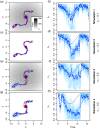A real-time data assimilative forecasting system for animal tracking
- PMID: 35405019
- PMCID: PMC9541799
- DOI: 10.1002/ecy.3718
A real-time data assimilative forecasting system for animal tracking
Abstract
Monitoring technologies now provide real-time animal location information, which opens up the possibility of developing forecasting systems to fuse these data with movement models to predict future trajectories. State-space modeling approaches are well established for retrospective location estimation and behavioral inference through state and parameter estimation. Here we use a state-space model within a comprehensive data assimilative framework for probabilistic animal movement forecasting. Real-time location information is combined with stochastic movement model predictions to provide forecasts of future animal locations and trajectories, as well as estimates of key behavioral parameters. Implementation uses ensemble-based sequential Monte Carlo methods (a particle filter). We first apply the framework to an idealized case using a nondimensional animal movement model based on a continuous-time random walk process. A set of numerical forecasting experiments demonstrates the workflow and key features, such as the online estimation of behavioral parameters using state augmentation, the use of potential functions for habitat preference, and the role of observation error and sampling frequency on forecast skill. For a realistic demonstration, we adapt the framework to short-term forecasting of the endangered southern resident killer whale (SRKW) in the Salish Sea using visual sighting information wherein the potential function reflects historical habitat utilization of SRKW. We successfully estimate whale locations up to 2.5 h in advance with a moderate prediction error (<5 km), providing reasonable lead-in time to mitigate vessel-whale interactions. It is argued that this forecasting framework can be used to synthesize diverse data types and improve animal movement models and behavioral understanding and has the potential to lead to important advances in movement ecology.
Keywords: animal movement; continuous-time correlated random walk; data assimilation; ecological forecasting; particle filter; potential function; southern resident killer whale; state augmentation; state-space models; trajectory prediction; whale collision avoidance.
© 2022 The Authors. Ecology published by Wiley Periodicals LLC on behalf of The Ecological Society of America.
Conflict of interest statement
The authors declare no conflict of interest.
Figures





References
-
- Abrahms, B. , Welch H., Brodie S., Jacox M. G., Becker E. A., Bograd S. J., Irvine L. M., Palacios D. M., Mate B. R., and Hazen E. L.. 2019. “Dynamic Ensemble Models to Predict Distributions and Anthropogenic Risk Exposure for Highly Mobile Species.” Diversity and Distributions 25(8): 1182–93.
-
- Auger‐Méthé, M. , Newman K., Cole D., Empacher F., Gryba R., King A. A., Leos‐Barajas V., et al. 2020. “An Introduction to State‐Space Modeling of Ecological Time Series.” arXiv preprint arXiv:2002.02001.
-
- Barlow, D. R. , and Torres L. G.. 2021. “Planning Ahead: Dynamic Models Forecast Blue Whale Distribution with Applications for Spatial Management.” Journal of Applied Ecology 58(11): 2493–504.
-
- Brillinger, D. R. , Preisler H. K., Ager A. A., and Kie J.. 2012. “The Use of Potential Functions in Modelling Animal Movement.” In Selected Works of David Brillinger, edited by Guttorp P. and Brillinger D., 385–409. New York, NY: Springer.
Publication types
MeSH terms
Associated data
LinkOut - more resources
Full Text Sources
